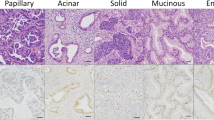Abstract
Our previous data indicate that the expression of the PLK gene which codes for a serine/threonine kinase is restricted to proliferating cells. In Northern blot experiments PLK mRNA expression was at the limit of detection in normal lung tissue but elevated in most samples of non-small cell lung cancer (NSCLC). A very low frequency of PLK transcripts was only found in bronchiolo-alveolar carcinomas. NSCLC patients whose tumors showed moderate PLK expression survived significantly longer (5 year survival rate=51.8%) than those with high levels of PLK transcripts (24.2%, P=0.001). No statistically significant correlation was found between PLK mRNA expression and age, sex, TNM status, histological type or degree of differentiation. Interestingly, the prognosis of patients in post-surgical stages I and II was correlated with PLK expression (5 year survival rates in stage I: 69.1% (moderate PLK) – 43.5% (high PLK), P=0.03 or in stage II: 51.9% (moderate PLK) – 9.9% (high PLK), P=0.006). These results suggest that PLK mRNA expression provides a new independent prognostic indicator for patients with NSCLC.
Similar content being viewed by others
Author information
Authors and Affiliations
Rights and permissions
About this article
Cite this article
Wolf, G., Elez, R., Doermer, A. et al. Prognostic significance of polo-like kinase (PLK) expression in non-small cell lung cancer. Oncogene 14, 543–549 (1997). https://doi.org/10.1038/sj.onc.1200862
Received:
Revised:
Accepted:
Issue Date:
DOI: https://doi.org/10.1038/sj.onc.1200862
- Springer Nature Limited
Keywords
This article is cited by
-
Mitotic protein kinase-driven crosstalk of machineries for mitosis and metastasis
Experimental & Molecular Medicine (2022)
-
A dimerization-dependent mechanism regulates enzymatic activation and nuclear entry of PLK1
Oncogene (2022)
-
ALKBH4 promotes tumourigenesis with a poor prognosis in non-small-cell lung cancer
Scientific Reports (2021)
-
Upregulation of Excision Repair Cross-Complementation Group 6-Like (ERCC6L) Promotes Tumor Growth in Hepatocellular Carcinoma
Digestive Diseases and Sciences (2021)
-
Active PLK1-driven metastasis is amplified by TGF-β signaling that forms a positive feedback loop in non-small cell lung cancer
Oncogene (2020)




